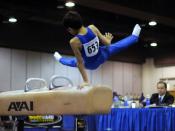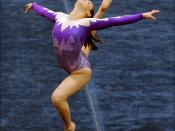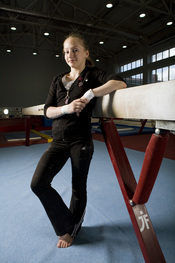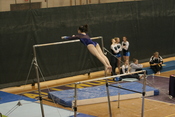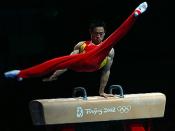Pesnek, L. (1998). The gymnastics almanac. Chicago, Illinois: Lowell House.
Gymnastics, like any sport, can be dangerous. According to the USA Gymnastics Safety Manual, the philosophy in the sport of gymnastics should be "Safety first, second, and always." Although most gymnastics clubs try to eliminate all potential dangers in the gym, injuries still may occur. The most common gymnastics injuries involve the lower leg and lower arm. It is important to keep safety in mind when entering a gym. A gymnast should not walk into the gym, throw her body into the air, and hope to land safely. Skills and progression must be taken one step at a time.
Most gymnastics classes start out with a warm-up activity, which lasts five to ten minutes to get the body loose and ready for physical activity. Warm-up activities take many forms, from running through an obstacle course to dancing to jumping rope.
The exercises should be fairly simple but cause you to breathe hard. A warm-up engorges the major muscle groups with blood in order to heat up the body temperature. It also elevates the heart rate and takes the muscles and joints through an appropriate range of motion. Flexibility is a key to gymnastics; so many warm-ups may begin with jogging, jumping, hopping, or skipping-type activities, followed by stretching to gain flexibility. Working on splits is also very common in a gymnastics warm-up. The most important thing to remember with flexibility exercises is not to bounce but rather to hold the stretch. Gymnastics classes should conclude with a cool-down activity such as light stretching and simple movements to help the body make the transition from the vigorous training activity to a normal state.
Progressions are the key to learning gymnastics safely and efficiently. A progression takes a gymnast through the individual steps necessary to accomplish a skill. The coach should help the gymnast learn the proper technique for the first progression. Another progression to consider is trying to master a skill on the floor before trying it on another apparatus. It is important to learn tumbling skills in an orderly and progressive manner""paying attention to the basics is crucial. Every skill learned in tumbling will help the gymnast to learn more difficult skills, both in tumbling and in other events. Coaches should not allow their gymnasts to take shortcuts just to learn a skill for its own sake; gymnasts should take the time and extra effort to learn the skill correctly. The basics should be taught and learned with precision, amplitude, and grace.
Training aids are also popular in teaching gymnastics. A training aid is something that is used to help a gymnast learn a particular skill. For example, an instructor teaching handstands may have her gymnast kick up to the handstand against a mat that is leaning against the wall, which holds the gymnast is place. Doing this allows the students to practice their handstands against the wall on their own while the instructor moves around the room, helping different students.
There are other ways that instructors teach gymnastics. The instructor may spot, manually assist, the gymnast in order to encourage the proper body position, facilitate the correct movement sequence, and to protect the gymnast. The instructor may put the gymnast in a hand belt or an overhead belt. The hand belt requires two experienced instructors to use a spotting belt with ropes. It is somewhat inefficient with larger groups since it requires two experienced spotters and each athlete must wear a belt. The overhead belt only requires one spotter but is still not very efficient since the students have to get in and out of the belt. Another form of spotting is the hands-off, or safety spotting. This is when the coach positions himself in an area where the gymnast might encounter a problem. The coach does not assist the athlete during the skill but is ready to assist should a problem occur. Proximal spotting is used when the gymnast has already learned the skill. This is when the coach is not in a position to physically spot the gymnast but remains close enough to provide verbal cues, reinforcements, and individualized instruction.
Beginning in August of 1998, gymnastics became a little safer. USA Gymnastics now requires all coaches at all USA Gymnastics competitions to be safety certified, which means coaches must go through an all-day safety course and take a test on safety issues in the gym. Just like individuals must pass a driver's test in order to get a driver's license, coaches must now pass this safety test in order to get a "coaching license."
